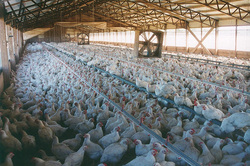
A day in the life of an animal "living" on a factory farm is one of misery, dispair, and great pain. Animals have been and continue to be an important food source for humans, however, most livestock animals in the United States are raised in confinement in huge industrialized systems. Factory or industrial farms are large, profit driven companies that view animals as units of production rather than living, breathing creatures and place efficiency and profit ahead of the health and welfare of the animal. Factory farms push for the maximum production from the animals regardless of the stress placed on the animal. Confining such a high density of animals may maximize profit and efficiency, however, the animals are exposed to higher levels of toxins from decomposing manure. This not only places the animal in inhumane environment but also creates the ideal conditions for diseases to spread, many of which can affect humans. Scientists have linked animal stress to problems wit h food quality and safety. In an attempt to counteract the diseases that arise from these unhealthy conditions, factory farmed animals are given constant low doses of antibiotics, contributing to the development of antibiotic-resistant bacteria.
In addition to packaging the animals into the facilities, factory farms feed animals an unnatural diet in order to maximize profits and efficiency. Most livestock animals do not leave the confinement of the factory farms, never seeing sunlight or having the pleasure of walking on grass. In order to increase productivity, factory farmed animals are also given hormones, pesticides, and other unhealthy additives. An excellent example is cattle. 32% of cattle raised on feedlots suffer from liver abscesses but managers choose not to change diets but rather place more additives in the food.
As for slaughtering, there are USDA standards for cleanliness and humane treatment during slaughter, however, this is the business of killing animals and the faster the slaughter process is, the more meat is produced and the more money is made. This inevitably leads to mistakes that violate USDA regulations and result in the cruel and inhumane treatment of the animals. Slaughterhouses are regularly reported as failing to completely stun animals before the slaughtering process begins, resulting in a cow (or other animal) being hung and bled out while still conscious.
While there are many more statistics and practices that I have not even mentioned in this brief summary of our discussion on slaughterhouses and factory farms, below are additional links to websites with more detailed information. The last two links are to websites where you can learn about food labeling and which labels indicate food from an animal that has been humanely treated and where to find restaurants, farmers, stores, and markets that sell food items from local farms, who treat their animals humanely. There is also a video produced by PETA and Paul McCartney on slaughterhouses called "If slaughter houses had glass walls, everyone would be a vegetarian." While graphic, it is very true to the industry that is far too present in our society.
More information on factory farming
Veal industry information
Dairy industry information
Food labeling
Find a local farm
In addition to packaging the animals into the facilities, factory farms feed animals an unnatural diet in order to maximize profits and efficiency. Most livestock animals do not leave the confinement of the factory farms, never seeing sunlight or having the pleasure of walking on grass. In order to increase productivity, factory farmed animals are also given hormones, pesticides, and other unhealthy additives. An excellent example is cattle. 32% of cattle raised on feedlots suffer from liver abscesses but managers choose not to change diets but rather place more additives in the food.
As for slaughtering, there are USDA standards for cleanliness and humane treatment during slaughter, however, this is the business of killing animals and the faster the slaughter process is, the more meat is produced and the more money is made. This inevitably leads to mistakes that violate USDA regulations and result in the cruel and inhumane treatment of the animals. Slaughterhouses are regularly reported as failing to completely stun animals before the slaughtering process begins, resulting in a cow (or other animal) being hung and bled out while still conscious.
While there are many more statistics and practices that I have not even mentioned in this brief summary of our discussion on slaughterhouses and factory farms, below are additional links to websites with more detailed information. The last two links are to websites where you can learn about food labeling and which labels indicate food from an animal that has been humanely treated and where to find restaurants, farmers, stores, and markets that sell food items from local farms, who treat their animals humanely. There is also a video produced by PETA and Paul McCartney on slaughterhouses called "If slaughter houses had glass walls, everyone would be a vegetarian." While graphic, it is very true to the industry that is far too present in our society.
More information on factory farming
Veal industry information
Dairy industry information
Food labeling
Find a local farm
 RSS Feed
RSS Feed